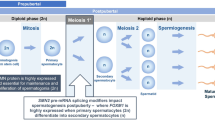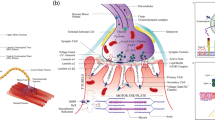Summary
Acrylamide neuropathy is characterized by distal multifocal axonal degeneration. In this condition long and large myelinated fibers are affected more than short and thin fibers. The purpose of the present study was to investigate the sequence of nerve terminal involvement. The study was limited to axons that belonged to one type of neuron, of approximately equal diameter but differing in length. Axon terminals from α motor neurons were investigated in five muscles from rats. The results show that the initial motor nerve terminal degeneration is widespread and not restricted to terminals of the longest axons with the largest volumes. It is suggested that the variation in degree of involvement of the motor nerve terminals is determined both by differences between endplates and the regenerative capacity of neurons.
Similar content being viewed by others
References
Boyd, I. A., Davey, M. H.: Composition of peripheral nerves, pp. 31–32. Edinburgh, London: Livingstone 1968
Bradley, W. G., Williams, M. H.: Axoplasmic flow in axonal neuropathies. 1. Axoplasmic flow in cats with toxic neuropathies. Brain96, 235–246 (1973)
Cavanagh, J. B.: The significance of the “dying back” process in experimental and human neurological disease. Int. Rev. Exp. Pathol.3, 219–267 (1964)
Evans, R. H., Haynes, J., Morris, C. J., Woolf, A. L.: In vitro staining of intramuscular nerve endings. J. Neurol. Neurosurg. Psychiatry33, 783–785 (1970)
Fullerton, P. M., Barnes, J. M.: Peripheral neuropathy in rats produced by acrylamide. Br. J. Ind. Med.23, 210–221 (1966)
Gauthier, G. F.: The motor end-plate: structure. In: The peripheral nerve. Landon, D. N. (ed.), pp. 464–494. London: Chapman and Hall 1976
Gipon, L., Schotman, P., Jennekens, F. G. I., Gispen, W. H.: Polyneuropathies and CNS protein metabolism. I. Description of the acrylamide syndrome in rats. Neuropathol. Appl. Neurobiol.3, 115–123 (1977)
Griffin, J., Price, D. L.: Fast axonal transport through giant axonal swcllings in hexacarbon neuropathy. J. Neuropathol. Exp. Neurol.36, 603 (1977)
Hopkins, A.: The effect of acrylamide on the peripheral nervous system of the baboon. J. Neurol. Neurosurg. Psychiatry33, 805–816 (1970)
Mendell, J. L., Sahenk, Z., Weiss, H. S.: Relationship of axonal swelling to abnormalities in fast axoplasmic transport. Neurology (Minneap.)27, 393 (1977)
Prineas, J.: The pathogenesis of dying-back polyneuropathies. II. An ultrastructural study of experimental acrylamide intoxication in the cat. J. Neuropathol. Exp. Neurol.28, 598–621 (1969)
Schaumburg, H. H., Wisniewski, H., Spencer, P. S.: Ultrastructural studies of the dying-back process. I. Peripheral nerve terminal and axon degeneration in systemic acrylamide intoxication. J. Neuropathol. Exp. Neurol.33, 260–284 (1974)
Schoental, R., Cavanagh, J. B.: Mechanisms involved in the “dying-back” process. — An hypothesis implicating coenzymes. Neuropathol. Appl. Neurobiol.3, 145–147 (1977)
Schotman, P., Gipon, L., Jennekens, F. G. I., Gispen, W. H.: Polyneuropathies and CNS protein metabolism. II. Changes in the incorporation rate of leucine during acrylamide intoxication. Neuropathol. Appl. Neurobiol.3, 125–136 (1977a)
Schotman, P., Jennekens, F. G. I., Gispen, W. H.: Polyneuropathies and neural protein metabolism: an evaluation. In: Mechanisms, regulation and special functions of protein synthesis in the brain. Roberts, S., Lajtha, A., Gispen, W. H. (eds.), pp. 407–422. Amsterdam: Elsevier 1977b
Schotman, P., Gipon, L., Jennekens, F. G. I., Gispen. W. H.: Polyneuropathies and CNS protein metabolism. III. Changes in protein synthesis rate induced by acrylamide intoxication. J. Neuropathol. Exp. Neurol. (in press) (1978)
Spencer, P. S., Schaumburg, H. H.: A review of acrylamide neurotoxicity. Part II. Experimental animal neurotoxicity and pathologic mechanisms. Can. J. Neurol. Sci.1, 152–169 (1974)
Spencer, P. S., Schaumburg, H. H.: Central-peripheral distal axonopathy, the pathology of dying-back polyneuropathies. In: Progress in neuropathology. Zimmerman, H. M. (ed.), vol. III, pp. 253–295. New York: Grune and Stratton 1977
Sumner, A. J., Asbury, A. K.: Physiological studies on the dying-back phenomenon. Muscle stretch afferants in acrylamide neuropathy. Brain98, 91–100 (1975)
Sumner, A. J.: Physiology of dying-back neuropathies. In: Physiology and pathobiology of axons. Waxman, S. G. (ed.), pp. 349–359. New York: Raven Press 1978
Tsujihata, M., Engel, A. G., Lambert, E. H.: Motor end-plate fine structure in acrylamide dying-back neuropathy: A sequential morphometric study. Neurology (Minneap.)24, 849–856 (1974)
Author information
Authors and Affiliations
Rights and permissions
About this article
Cite this article
Jennekens, F.G.I., Veldman, H., Schotman, P. et al. Sequence of motor nerve terminal involvement in acrylamide neuropathy. Acta Neuropathol 46, 57–63 (1979). https://doi.org/10.1007/BF00684805
Received:
Accepted:
Issue Date:
DOI: https://doi.org/10.1007/BF00684805




